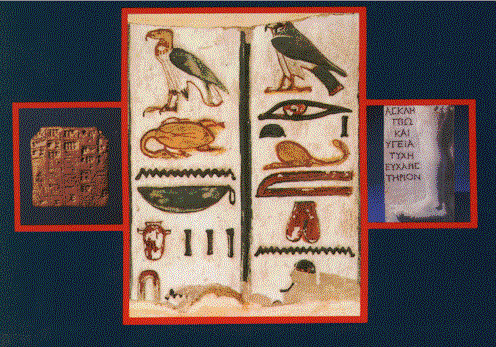


..
Castells rehearses the argument that the invention of the alphabet brought
about a revolution in communication that laid the foundation for the
accumulation of information in later times:
..
"Around 700 BC a major invention took place in Greece: the alphabet. This
conceptual technology, it has been argued by leading classics scholars such as
Havelock, was the foundation for the development of Western philosophy and
science as we know it today. It made it possible to bridge the gap from spoken
tongue to language, thus separating the spoken from the speaker, and making
possible conceptual discourse. This historical turning point was prepared for
by about 3,000 years of evolution in oral tradition and nonalphabetic
communication, until Greek society reached what Havelock calls a new state of
mind, the...
alphabetic mind
..
...that prompted the qualitative transformation of
human communication (Eric A. Havelock).
..
Widespread literacy did not occur until many centuries later, after the
invention and diffusion of the
printing press
and the
manufacturing of
paper.
..
Yet it was the alphabet that, in the West, provided the mental infrastructure
for cumulative, knowledge-based communication. However, the new alphabetic
order, while allowing rational discourse, separated written communication from
the audiovisual system of symbols and perceptions, so critical for the
full-fledged expression of the human mind.
By implicitly and explicitly establishing a social hierarchy between literate
culture and audiovisual expression, the price paid for the foundation of human
practice in the written discourse was to relegate the world of sounds and
images to the backstage of the arts, dealing with the private domain of
emotions and with the public world of liturgy. Of course, audiovisual culture
took an historical revenge in the twentieth century, first with film and radio,
then with television, overwhelming the influence of written communication in
the hearts and souls of most people. Indeed, this tension between noble,
alphabetic communication and sensorial, nonreflective communication underlies
the intellectuals' frustration against the influence of television that still
dominates the social critique of mass media (Postman 1985)." (Castells 1996:
326f.)
..
The development of the individual letters of the alphabet from North Semitic to
Modern capitals can be seen in the following table:
Reading on the Alphabet
..
David Diringer, Writing (London 1962).
Eric A. Havelock, Preface to Plato (Cambridge, Mass., 1963).
Eric A. Havelock, The literate revolution in Greece and its cultural
consequences (Princeton, N.J., 1982).
J.T. Hooker (ed.), Reading the Past: Ancient Writing from Cuneiform to the
Alphabet (London 1990).
..
Havelock
The Greek alphabet, by way of contrast, is here introduced, when it impinges on
the Greek scene, as a piece of explosive technology, revolutionary in its
effects on human culture, in a way not precisely shared by any other invention.
Uniqueness is claimed for it in the fact that, while emerging from a process of
experimentation which covered perhaps three previous millennia, it constituted
the terminus of the process. Once invented, it supplied the complete answer to
a problem, and there has never been need to reinvent it.
..
The Roman and Cyrillic variants are just that, and no more. The problem had
been to devise a system of 'shapes' (as the Greeks properly called them) of
required small sizes, with maximum economy, (so far, the Phoenician
achievement) such as would, despite the economy, when seen (or as we say,
'read') in endless variety of linear arrangements automatically trigger an
acoustic memory of the complete spoken speech indexed by the shapes. The Greek
device, because of its success in solving the last stage of the problem,
brought into existence what we call 'literature' in the modern, i.e.
postalphabetic. It can even be argued that the device furnished a necessary
conceptual foundation on which to build the structures of the modern sciences
and philosophies.